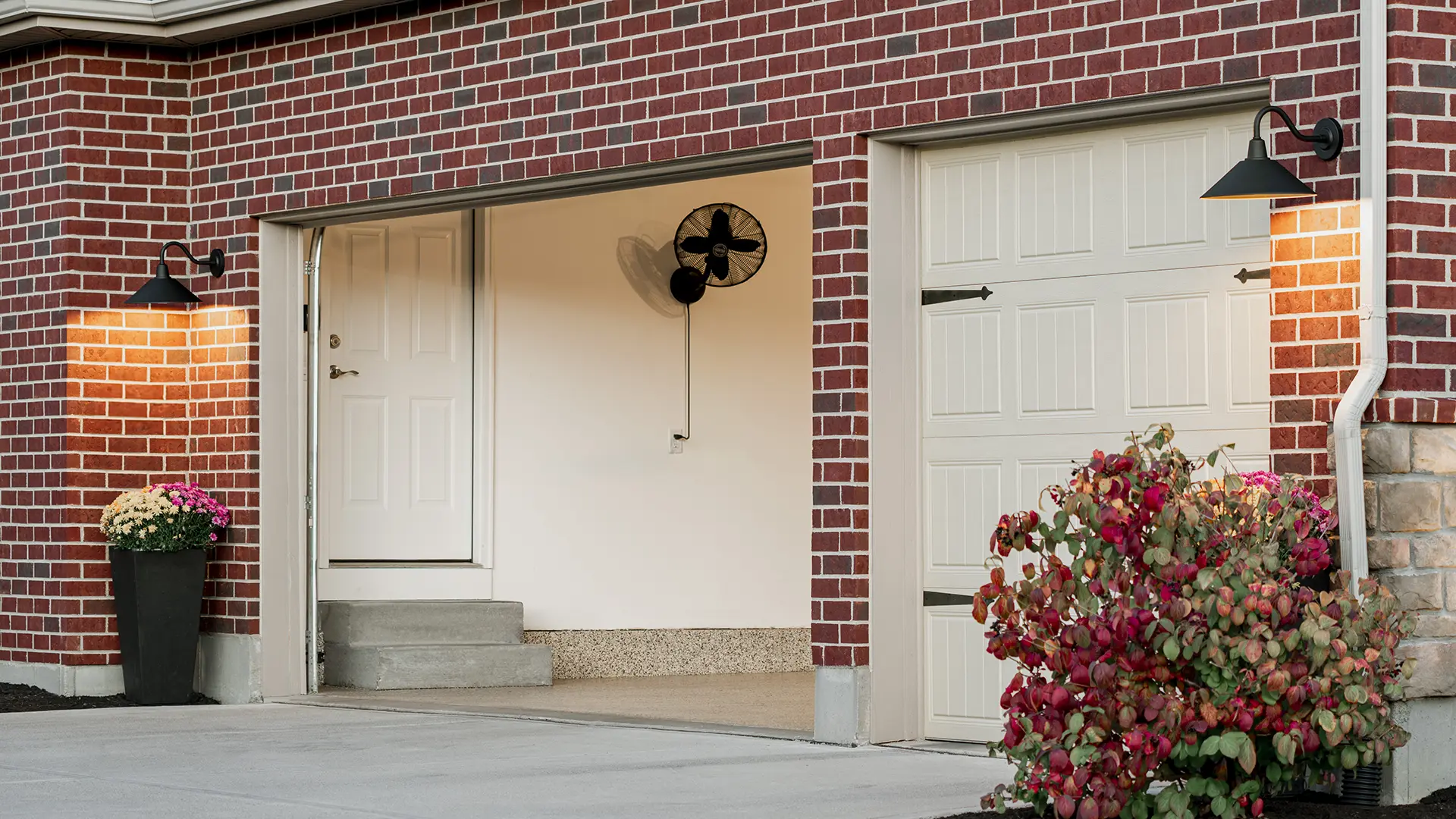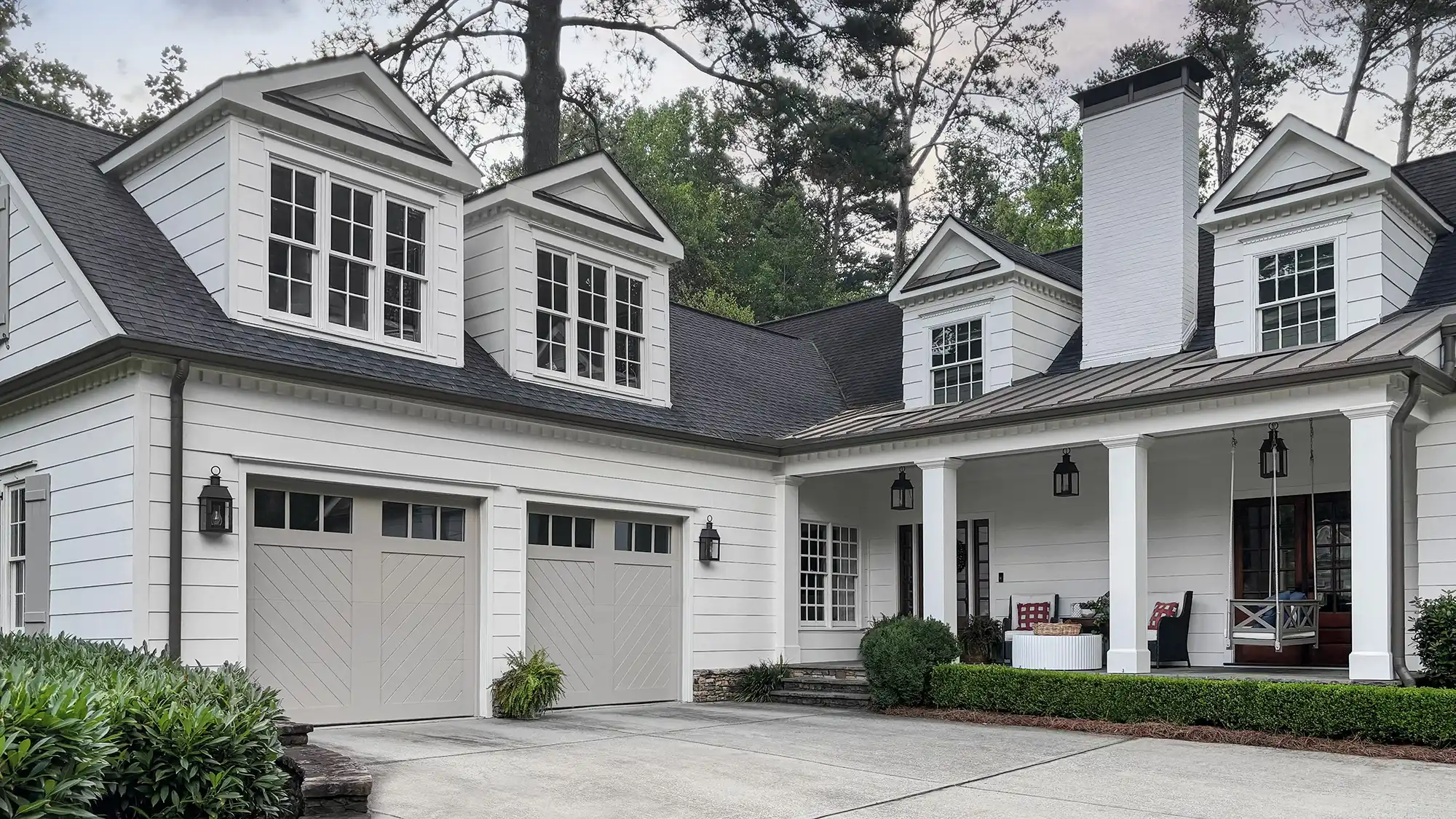Adding a ceiling fan to the garage not only helps air circulation and the overall comfort level of the space, but it’s another opportunity for homeowners to showcase their design preferences. Industrial enthusiasts will appreciate fans with sturdy builds and edgy, unfinished designs. For a rustic vibe, consider a fan with distressed wood blades. Those favoring sleekness can find modern fans with streamlined profiles and minimal ornamentation. Timeless contemporary designs also exist to keep your space fresh and current. Beyond aesthetics, it’s important to select a quality fan that fits with your garage's dimensions, layout, and can withstand moisture from outdoors.
We’ve partnered with Hunter Fan Company for a garage makeover giveaway – inside and out. One winner will receive a top-of-the-line Oscillating Wall Mounted Fan 16”, Universal Mounting System, and outdoor lighting (up to $500-worth) and a $500 credit towards a Clopay garage door – a value of $1,000. Enter to win here! In the meantime, here are some ideas to find the perfect fan for your space.
Types of Garage Ceiling Fans

First, to answer the obvious question: Yes, you can install a ceiling fan in a garage, provided there's sufficient clearance between the fan and any obstacles. Review your local building code for specifics, but you’ll want to make sure there's ample headroom above the fan, as well as clearance from vehicle rooftops and equipment, to safely circulate air.
With so many garage ceiling fan options available, you’ll want to consider your garage's unique characteristics to help you narrow down the choices. Some types of garage ceiling fans include:
Low-Profile Fans for Compact Spaces
Garages with limited clearance benefit from low-profile ceiling fans. These sleek, flush-mount designs maximize overhead room while still providing a strong airflow. Choose a low-profile fan when vertical space is at a premium.
Extended Downrod Fans for High Ceilings
In garages with taller ceilings, fans with downrod extensions ensure optimal air circulation throughout the extensive overhead area. This style is ideal for workshops or spaces with angled roofs.
Weather-Resistant Fans for Exposed Garages
If your garage is exposed to the elements, make sure to get a damp- or wet-rated outdoor ceiling fan that can withstand the conditions. Wet-rated fans offer maximum moisture resistance, while damp-rated options suit partially sheltered areas.
Industrial-Grade Fans
Larger garages benefit from industrial fans. These heavy-duty models have more powerful motors and larger blades to move massive amounts of air. They often lack lighting but make up for it with sheer airflow.
Dual Ceiling Fans
For a unique look and extra circulation, consider dual fans. These have two rotors spinning in tandem. They work well in longer, narrower garages to create a cross breeze.
Smart Ceiling Fans
Tech-savvy garage owners might prefer smart fans. These Wi-Fi enabled fans can be controlled remotely through an app, scheduled, and even work with voice assistance for hands-free operation.
Energy-Efficient Fans
Eco-conscious homeowners will appreciate Energy Star-rated fans. These models use advanced materials and design for maximum airflow while minimizing power consumption.
No matter which type of garage ceiling fan you choose, make sure it's rated for your garage's specific conditions and installed by a licensed electrician for safety.
Can I Have a Ceiling Fan and a Garage Door Opener?
In most cases, yes, you can have both a ceiling fan and a garage door opener in your garage. One way to accommodate both is to install a wall mount opener, also known as a side mount or jackshaft opener, which is typically found on either side of your garage door and eliminates the need for an overhead rail. This style is common in garages with high or irregularly shaped ceilings. It allows you to place a ceiling fan in the center of the garage.
Jackshaft openers connect directly to the torsion bar above a garage door. And because they don’t require the lengthy chains or belts found on traditional overhead openers, it significantly reduces the noise level. As side-mount units, they also forego the track system that typically spans the garage ceiling.
Another option is to install an oscillating wall mounted fan. True, it’s technically not a ceiling fan, but if you have a traditional overhead opener in the center of the ceiling, a fan mounted in an open corner of the garage can still keep the air moving throughout the space.
Can You Put an Indoor Ceiling Fan in the Garage?
Generally, it's not recommended to install a standard indoor ceiling fan in a garage, especially if the garage is not climate-controlled or is exposed to the elements. Here's why:
Moisture: Garages, especially those with concrete floors, can be prone to moisture. Indoor fans aren't sealed against dampness and could corrode over time.
Dust and Debris: Garages tend to be dustier than indoor living spaces. This can weigh down the fan blades, put stress on the motor, and require more frequent cleaning.
Temperature Extremes: Uninsulated garages can get very hot in summer or cold in winter. Indoor fans might not be built to withstand these temperature fluctuations.
Vibration: Garages often have garage door openers and other machinery that can cause vibration. Indoor fans may not be designed to handle this extra movement.
If you still want to install a ceiling fan in your garage, look for one specifically rated for "garage use" or "damp" locations. These fans have materials and coatings to resist moisture and corrosion. They might also be built to handle some vibration and extreme temperatures.
How Do You Install a Ceiling Fan in the Garage?
Installing a ceiling fan can be a DIY-friendly project if you're comfortable with heights and basic electrical work. Remember, specific steps may vary by fan model, so always consult your manufacturer's instructions. And if you’re unsure about installing it yourself, don’t hesitate to hire a certified electrician. Here’s an Overview of how to install a ceiling fan using Hunter’s Universal Mounting System:
Measure your Space
- Ensure there is 30 inches from the blade tip to the nearest wall or obstruction.
- Ensure there is 7 feet from the bottom edge of the blade to the floor.
Prepare the Area
- Turn off power to the circuit at the breaker box. Verify the fan is dead with a non-contact voltage tester.
- Make sure the existing ceiling mount is rated for the weight of your new fan. Most standard mounts handle up to 70 pounds.
- If you have an outdated or flimsy mount, upgrade to a sturdier one.
Mount the Fan using Universal Mounting System
- Hold the Universal Mount to the ceiling mount and mark the screw holes.
- Attach your fan’s bracket to the Universal Mount with the bracket screws.
- Follow along with the instructions for Universal Mount.
- Assemble your fan using the manufacturer’s instructions including wiring.
- Plug the Universal Mount into the wall outlet to power the fan.
Test the Fan and Remote Control
- Turn the power back on at the breaker.
- Test the fan on all speeds, ensuring smooth operation.
- Check any lights for proper function.
- Test to make sure remote control, wall control or pull chain is working properly.
Important Safety Notes
- Ensure the power is completely off at the circuit breaker before starting the project. The power should remain off until the entire fan installation is finished.
- Refer to the manufacturer's instructions for supplementary safety and warning details.
- Confirm the installation location has a correctly installed ceiling fan-rated box that can support the weight of your fan or verify you can directly attach your fan to the building structure.
- Verify there are no obstructions present at the intended ceiling fan installation location.
- Don’t mess around with electricity. Hire a pro if the installation becomes too daunting of a task.
Shop Clopay for a New Garage Door to Complement Your Ceiling Fan
A garage ceiling fan is a practical upgrade, enhancing airflow and comfort in your workspace. But why stop there? Pair your new fan with a top-notch garage door from Clopay. Their doors offer durability, insulation, and sleek designs to elevate your home's curb appeal. With a wide selection of materials, styles, and customization options, Clopay has a door to match any budget and aesthetic.
Helpful Articles
Guide to Garage Door Remote Programming





